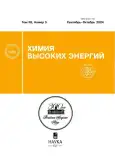Effect of gamma irradiation dose on papain toxicity
- Authors: Allayarova U.Y.1, Demidov S.V.1, Blokhina S.V.1, Rayevskaya T.A.1, Mishchenko D.V.1, Omelchuk Y.A.2, Allayarov S.R.1
-
Affiliations:
- Federal Research Center for Problems of Chemical Physics and Medicinal Chemistry, Russian Academy of Sciences
- Sevastopol National University
- Issue: Vol 58, No 5 (2024)
- Pages: 404-411
- Section: RADIATION CHEMISTRY
- URL: https://pediatria.orscience.ru/0023-1193/article/view/684848
- DOI: https://doi.org/10.31857/S0023119324050097
- EDN: https://elibrary.ru/TXKSIN
- ID: 684848
Cite item
Abstract
Study of the effect of a wide range of γ-irradiation doses from 250 to 3000 kGy on acute toxicity of papain when administered to laboratory animals. It was found for the first time that preliminary γ-irradiation of papain up to 1000 kGy reduces toxicity of its aqueous dispersions at intraperitoneal administration by more than five times. Further increase of irradiation dose up to 3000 kGy does not lead to a noticeable change in the toxic effect. The results of the study indicate that γ-irradiation of papain can be used to reduce its toxicity.
Keywords
Full Text
About the authors
U. Yu. Allayarova
Federal Research Center for Problems of Chemical Physics and Medicinal Chemistry, Russian Academy of Sciences
Email: sadush@icp.ac.ru
Russian Federation, Chernogolovka
S. V. Demidov
Federal Research Center for Problems of Chemical Physics and Medicinal Chemistry, Russian Academy of Sciences
Email: sadush@icp.ac.ru
Russian Federation, Chernogolovka
S. V. Blokhina
Federal Research Center for Problems of Chemical Physics and Medicinal Chemistry, Russian Academy of Sciences
Email: sadush@icp.ac.ru
Russian Federation, Chernogolovka
T. A. Rayevskaya
Federal Research Center for Problems of Chemical Physics and Medicinal Chemistry, Russian Academy of Sciences
Email: sadush@icp.ac.ru
Russian Federation, Chernogolovka
D. V. Mishchenko
Federal Research Center for Problems of Chemical Physics and Medicinal Chemistry, Russian Academy of Sciences
Email: sadush@icp.ac.ru
Russian Federation, Chernogolovka
Yu. A. Omelchuk
Sevastopol National University
Email: sadush@icp.ac.ru
Sevastopol Institute for Nuclear Energy and Industry
Russian Federation, SevastopolS. R. Allayarov
Federal Research Center for Problems of Chemical Physics and Medicinal Chemistry, Russian Academy of Sciences
Author for correspondence.
Email: sadush@icp.ac.ru
Russian Federation, Chernogolovka
References
- Kamphuis I.G., Kalk K.H., Swarte M.B., Drenth J. // J.Mol. Biol. 1984. V. 179. P. 233.
- Wong D.W.S. Food enzymes: structure and mechanism. NY: Springer Science + Business Media, 1995. P. 139.
- Shouket H.A., Ameen I.A., Tursunov O., Kholikova Kh., Pirimov O., Kurbonov N. et al. // IOP Conf. Ser.: Earth Environ. Sci. 2020. V. 614. Article 012171.
- Mahajan R.T., Chaudhari G. // Int.J. Adv. Res. 2014. V. 2. P. 1173.
- Abu-Alruz K., Mazahreh A.S., Quasem J.M., Hejazin R.K., El-Qudah J.M. // Am.J. Agricult. Biol. Sci. 2009. V. 4. P. 173.
- Polaina J., MacCabe A.P. Industrial enzymes: structure, function, and applications. Dordrecht: Springer, 2007. 641 P.
- Pietrasik Z., Shand P.J. // Meat Sci. 2011. V. 88. P. 8.
- Bekhit A.A., Hopkins D.L., Geesink G., Franks P. // Crit.Rev. Food Sci. Nutr. 2014. V. 54. P. 1012.
- Beeley J.A., Yip H.K., Stevenson A.G. // Brit. Dental J.: BDJ online. 2000. V. 188. P. 427.
- Mohr H., Desser L. // BMC Compl. Altern. Med. 2013. V. 13. P. 231.
- Akila M., Sushama A., Ramanathan K. // Int.J. Pharm. Pharm. Sci. 2014. V. 6. P. 160.
- Fauziya S., Krishnamurthy R. // CIB Tech J. Pharm. Sci. 2013. V. 2. P. 25.
- Nguyen T.T., Shaw P.N., Parat M.O., Hewavitharana A.K. // J.Mol. Nutr. Food. Res. 2013. V. 57. P. 153.
- Manal E.E. // EC Clin.Exp. Anatomy. 2018. V. 1. P. 40.
- Mironov А.N., Sakaeva I.V., Sakanyan E.I., Bunyatyan N.D., Kovaleva E.L., Mitkina L.I. et al. // Vedomosti Scientific Centre of expertise of means of medical use. 2012. № 3. P. 56.
- Allayarov S.R., Rudneva T.N., Demidov S.V., Allayarova U.Yu., Chekalina S.D. // High Energy Chemistry. 2024. V. 58. № 5 (in publication).
- Mekapogu A.R. // J. Inst. Actuar. 1952. V. 78. P. 388.
- Berezovskaya I.V. // Chem.–Pharm. J. 2003. V. 37. P. 32.
Supplementary files











